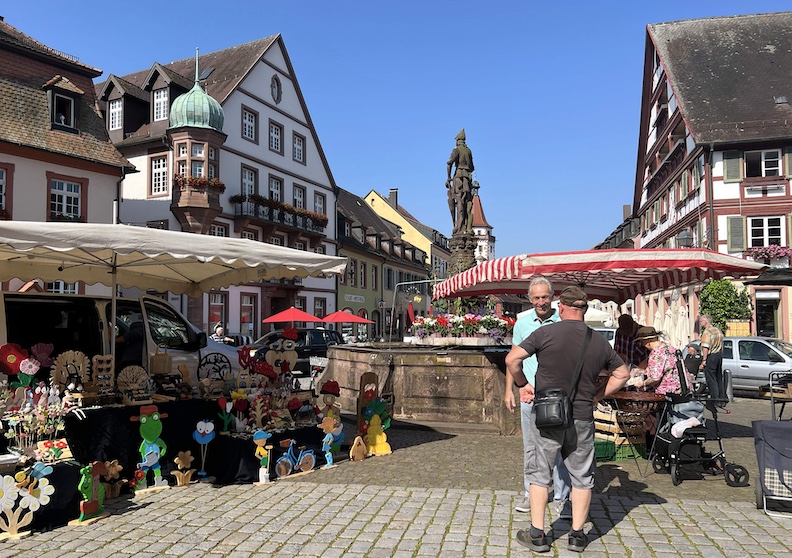
A colorful market in front of Gengenbach’s town hall on Marktplatz takes place every Wednesday and Saturday. Photo by Beth Reiber
By Beth Reiber
I lived in Germany for four years, studied at two German universities and wrote chapters for Frommer’s guidebooks on Berlin and Munich. But during all that time I never felt compelled to visit the Black Forest in Southwest Germany. Somehow, the thought of my German-speaking grandparents puttering through the Schwarzwald (as it’s called in German) on their biannual trips to Europe conjured an old-fashioned vacationland, filled with cuckoo clocks and sleepy villages. Now I can’t fathom why I ever thought those might be a deterrent.
A visit to the Black Forest suggests a romantic journey to an older era, the region’s primary draws are vineyards and hiking, activities my grandparents might have enjoyed, all set against a dramatic backdrop of wooded mountains, rolling vineyards, and villages of half-timbered homes. Perhaps my Opa and Oma even drove the Baden Wine Route, which celebrated its 70th anniversary in 2024 and links several hundred wineries along its 300-mile path, including vineyards in the Black Forest.
It Scared the Romans
The Black Forest got its name from the Romans, who found the woods so dark and dense that they named it Silva Nigra, a “black forest” that suggested otherworldliness. Today, after serving as Germany’s biggest source of lumber during the Industrial Revolution, the Black Forest’s 2,320 square miles have thinned to a shadow of their former impenetrable woods, a splendid mix of forested mountains of deciduous and coniferous trees laced with river valleys, vineyards, lush meadows, clear lakes, streams, and villages with their ubiquitous flower boxes overflowing with geraniums.
And that’s the crux of it. The Black Forest, measuring just 100 miles long and up to 25 miles wide, can be a cathedral for solitude, conveying feelings of both contentment and remoteness as shafts of sunlight play upon straight trunks to settle upon scattered leaves, fern-lined pathways, or beds of moss an iridescent green. For me, the piney fragrance settles body and mind. And though you can lose yourself following well-marked long-distance trails, heading downhill from the forest-blanketed summits past vineyards and orchards brings you to villages dating from the mists of time. It’s a joy to transition so easily between forest and medieval town.
But what makes the Schwarzwald special is its location in the state of Baden-Württemberg in Southwest Germany. Bordered by France to the west and Switzerland to the south, the forest has the warmest climate in the country. That makes it a pleasant destination no matter whether you’re going to a late August grape harvest or visiting a German Christmas market.
“What we have here is special,” says Anna Maria Freitag, the Black Forest tourism board’s manager of wine and culinary tourism. “We have a laid-back lifestyle and this Mediterranean lifestyle of delicious food. We are different from Munich and other places. People are very social here, super open.”
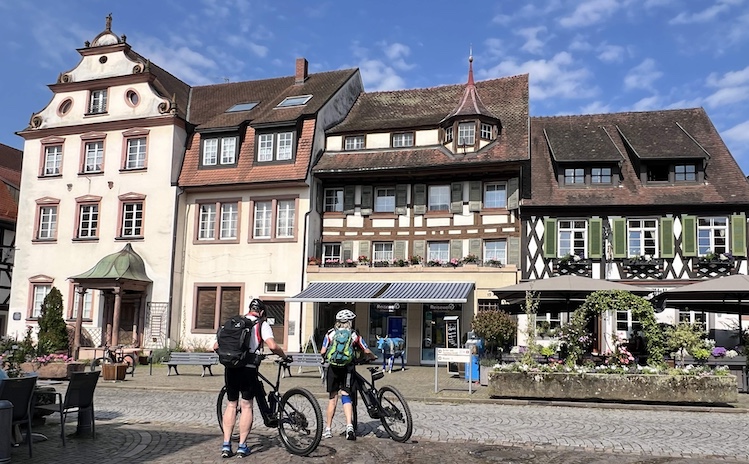
The Baden Wine Route, Baden Wine Cycle Path, and German Half-Timbered House Road all pass through Gengenbach. Photo by Beth Reiber
Part of that lifestyle revolves around the Baden wine region, the third-largest wine area in Germany. It stretches from villages north of Heidelberg south to the Swiss border, passing the western slopes of the Black Forest along the way. Many visitors choose to experience its many wineries by driving the Baden Wine Route, inaugurated in 1954 just four years after Germany’s most famous route, The Romantic Road, was created to bring tourism to post-war Germany.
Good Food and Great Wine
Riesling, Germany’s most famous wine, is naturally a big contender, but with the sunniest terrain in Germany – similar to the French wine regions of Alsace, Champagne, and the Loire – Baden also produces plenty of other wines, especially those made from pinot grapes.
“Baden is pinot country, proof that it’s always had a warmer temperature on the sunny side of Germany,” says Hubert Müller, a ninth-generation vintner living in the Ortenau district of the Baden wine region. “They call it the small Tuscany of Germany.”
Martin Renner, third-generation vintner and owner of the Julius Renner Weingut & Weinkeller in Ortenau, says it’s advantageous to spend a vacation where there are wineries. Not only are vineyards located in warm climates with typically good food and wine, but the people tend to be friendlier.
“People are communicative because they are always slightly drunk,” he jokes.
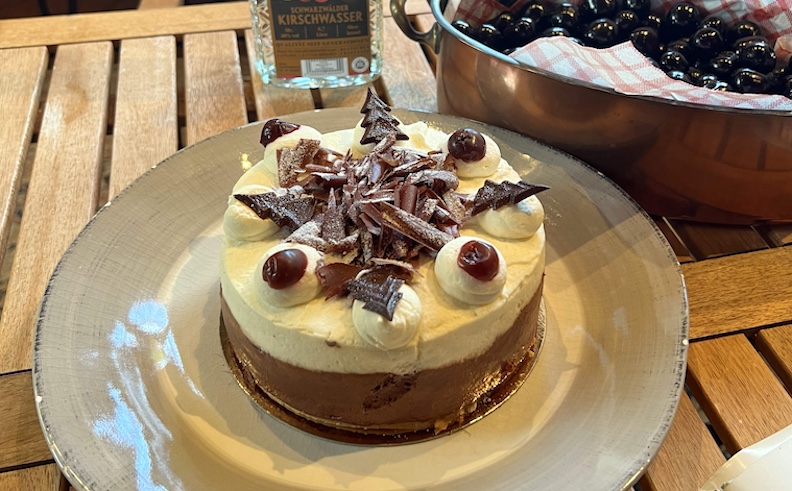
Black Forest Cake, which utilizes local ingredients like cherries and cherry schnapps, is famous throughout Germany. Photo by Beth Reiber
Baden is also a fruit paradise that finds expression not only in wines but also brandies, liqueurs, and desserts like Black Forest Cake (Schwarzwälder Kirschtorte), famous for its layers of dark chocolate and local cherries, doused in cherry schnapps and slathered in fresh whipped cream. It might be worth coming to the Black Forest just for that.
But it’s the fruit that makes me swoon, with orchards bearing cherries, plums, apples, pears, almonds, chestnuts, and walnuts. In Ortenau I tasted delicious strawberries that were sweet, juicy, and aromatic, without even a hint of tartness.
As for those cuckoo clocks, yes, they were conceived in the Black Forest, in the mid-18th century when a clockmaker designed a clock imitating the sound of a cuckoo. Another clockmaker came up with a door, through which the cuckoo emerged to announce the time and then disappear. Over time, the abundance of wood made clockmaking a trade and a way for locals to make money in winter. Sporting intricately carved rustic chalets and nature themes, cuckoo clocks became the must-have souvenir for tourists, spreading their fame near and far. You’ll find shops everywhere.
Off The Beaten Track Is a Good Thing
Baden’s hiking and biking paths and wine culture are no secret to the Germans and the Swiss and French living just across the border. Yet most of Baden remains unknown to Americans, who tend to stick to more popular destinations like the spa town of Baden-Baden, the university town of Freiburg, touristy Titisee, or Breisach, a stop for cruises along the Rhine.
Oberkirch is one of the Schwarzwald’s most picturesque villages, yet Americans account for fewer than five percent of its visitors. That might change if they knew Oberkirch and its surroundings are home to more than 1,000 distilleries. But this concentration is just a drop in the bucket compared to the 14,000 distilleries throughout the Black Forest.
In addition, a 285-mile cycling path and the German Half-Timbered House Road, which traverses nearly the entire length of Germany, both pass through the Black Forest. Add a national park and thousands of miles of well-marked hiking trails, and it’s clear that the Schwarzwald is the perfect antidote to Europe’s crowded cities, especially for active travelers.
Passionate Pastimes: Biking and Hiking
A slice of the Schwarzwald’s wild past is preserved in the Black Forest National Park, which opened in 2014 as one of Germany’s newest conservation areas. Its 40 square miles protect not only forests, moors, and lakes, but also inhabitants like the fastest bird (the Peregrine falcon clocked at 225 mph), the smallest owl (pygmy owl at just six to seven inches), and the rare three-toed woodpecker. The first stop should be the National Park Center, which opened in 2020 with interactive exhibitions that include a virtual reality tour and an open-air skywalk above the trees leading to a viewing tower. The national park also offers guided ranger walks, adventure trails, and cycling and hiking trails. But the park’s coolest aspect is that much of it is being left to its own devices, to return it to the most pristine state possible over the next few decades.
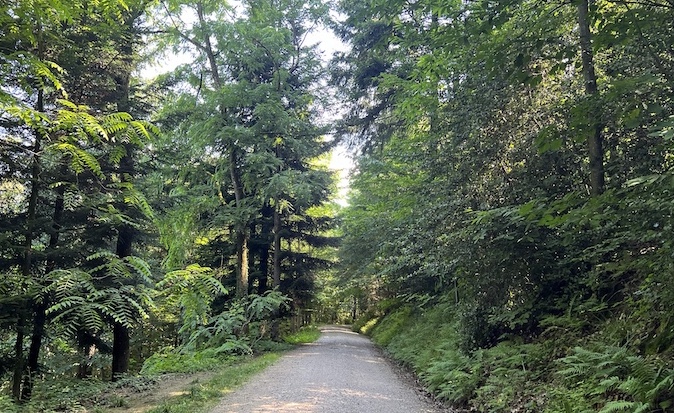
This hiking path between the Oberkirch village of Nussbach leads to Sankt Wendel, a pilgrimage chapel on the Saint Jacobs path (Jacobsweg). Photo by Beth Reiber
The Black Forest is crisscrossed with almost 15,000 miles of hiking trails, making it a huge destination for trekkers and that deeply popular German pastime, the Sunday stroll. Indeed, the Schwarzwald could be considered the birthplace of recreational hiking (Mark Twain referred to his hikes in the Black Forest as “pedestrianism” in A Tramp Abroad, published in 1880). The meandering 175-mile Westweg, considered one of Germany’s top trails and perhaps the most beautiful in the Black Forest, was laid out more than a century ago, making it one of the oldest recreational trails in the country.
Because Germany offers the freedom to roam with the right of entry (Betretungsrecht), you’re free to wander through uncultivated land and forests both public and private. Not that you need to wander off without a goal. Trails, all primly maintained in good German fashion and extremely well marked, range from short local walks and thematic trails (culinary or distillery hikes, anyone?) to regional hikes and long-distance treks, with plenty of maps, apps, and websites for guidance. They take in orchards, vineyards, forests, meadows, towns, waterfalls, scenic overlooks, and viewing towers. Although some trails are marked as strenuous, Black Forest mountains are not high. Feldberg, the tallest at 4,898 feet, is a dwarf compared to the Alps but is the center of skiing in the Black Forest, with a cable car to the summit providing panoramas also in summer.
Biking is also big in the Schwarzwald, especially since the 2020 opening of the Baden Wine Cycle Path (Badischer Weinradweg), which takes in seven of Baden’s nine wine-growing regions on its 285 miles of mostly asphalt cycling paths. Mountain biking, too, is popular. Bikes, including e-bikes, are available for rent in many towns.
Ortenau’s Medieval Towns
Because the Baden Wine Route stretches 300 miles through nine wine districts and includes hundreds of wineries, most people drive just part of it. The prettiest vineyards are arguably those that nestle along the northwestern slopes of the Black Forest, including those in the Ortenau wine district. Because Ortenau lies almost in the middle of the Baden wine region, it’s a perfect stopover or base for exploring sun-kissed vineyards, distilleries, ancient castles, hiking trails leading to panoramic views, and medieval towns like Gengenbach and Oberkirch, both of which are also accessible by rail. After that, you can get around free on buses and trains throughout the Black Forest region with the KONUS guest card, available for guests staying at 150 hotels and resorts in the region.
Gengenbach
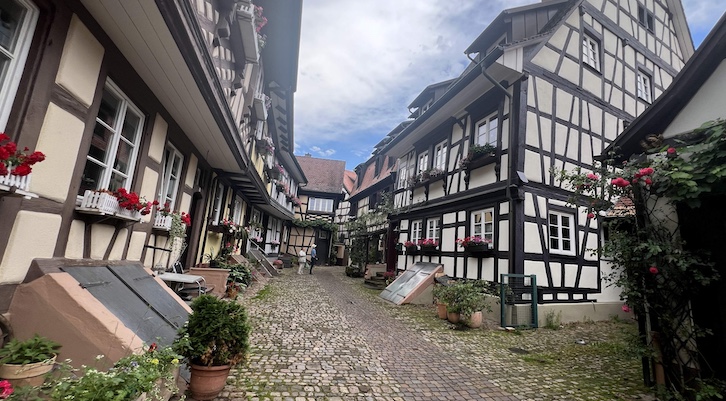
Many of the half-timbered houses in Gengenbach feature overhangs to support larger living spaces on upper floors and street entrances into their wine cellars. Photo by Beth Reiber
Nobody should miss Gengenbach, a town of about 10,000 souls. Its wine culture goes back 1,130 years when Benedictine monks planted the first vines in the 9th century. The town was founded later, in the 13th century, on abbey-owned land. Employees were paid not only a tidy sum of money but also received firewood, grain, and wine. It’s no wonder Gengenbach has a deeply rooted relationship to wine.
It’s also no wonder that Gengenbach is one of about 100 towns on the almost 2,000-mile German Half-Timbered House Road (Deutsche Fachwerkstrasse) or that Tim Burton’s “Charlie and the Chocolate Factory” was filmed here. The Baden Wine Cycle Path also passes through.
Citizens are proud that Gengenbach was an Imperial Free City from 1360 to 1801, meaning that it was a self-ruling city in the Holy Roman Empire and not under the laws of a territorial prince. Guard towers and church spires rise above the old townscape, which boasts a bustling farmer’s market on its cobblestone town square, the Benedictine Abbey, and picture-perfect lanes like Engelgasse (Angel Alley) and Höllengasse (Hell Alley), lined with half-timbered houses built by town craftsmen of yore.
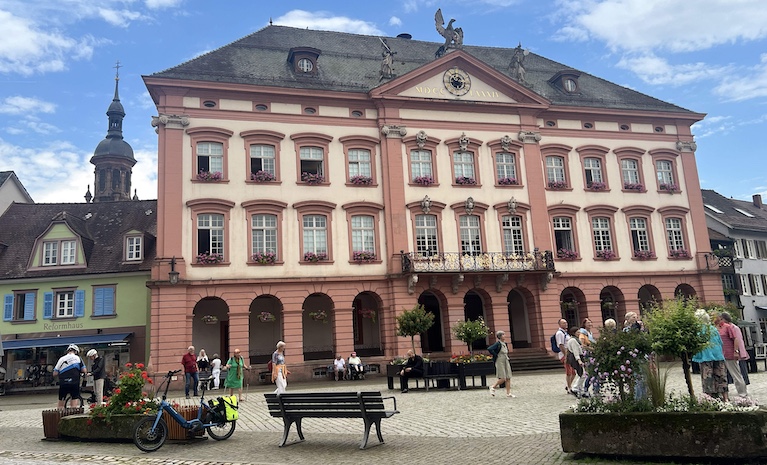
Gengenbach’s town hall. Photo by Beth Reiber
Like many towns in the Baden wine region, Gengenbach has an annual wine festival in September. But it’s most famous for its 240-year-old town hall, which transforms into the largest Advent calendar in the world every year from the end of November to Christmas Eve. That’s when its 24 decorated windows depict themes that have ranged from children’s books or fairy tales to works by Andy Warhol or Marc Chagall. Naturally, a Christmas market graces the main square, complete with crafts, Glühwein (mulled wine), and Leberkuchen (gingerbread cookies). This is Gengenbach’s biggest event of the year, attracting up to 100,000 people. Otherwise, you’ll find mostly independent travelers ambling through the streets of what is another underrated tourist destination in Southwest Germany.
Oberkirch
Oberkirch is even farther off the beaten path than Gengenbach. First mentioned in the 11th century, the town’s most distinguishable natural landmark is the Mühlbach Stream, where butchers once disposed of animal guts and tanners threw their poisons. Some half-timbered houses backing up to the stream even had overhanging privies that dumped into it. Today, colorful geraniums hang from boxes that line the clear stream, and half-timbered houses painted in pastels of light green, rose, or ochre radiate out into the old town, especially along stately Hauptstrasse (Main Street).
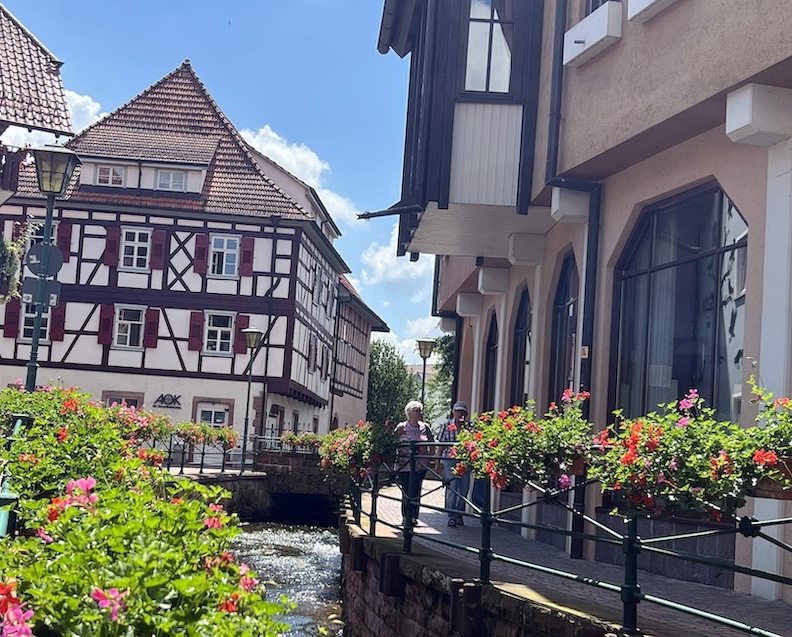
Oberkirch’s beautiful downtown Mühlbach Stream was once a dumping ground for animal guts, tannery waste and neighborhood privies. No longer. Today it is a pristine focal point for travelers enjoying the vineyards. Photo by Beth Reiber
But mostly, Oberkirch can be defined as a wine town. And a distillery town. And a fruit town.
Bountiful fruit led the Bishops of Strasbourg, who lived just 20 miles west across the Rhine River and had dominion over Oberkirch from 1303 to 1803, to grant distillation rights to farmers starting in 1726. Today the small town is surrounded by more than 1,000 quaint family distilleries. Anyone can make Schnaps (fruit brandy); all you need is a permit.
“This is fruit paradise,” says Anne-Kathrin Hormann, whose family-owned Franz Fies GmbH distillery got its start in 1948 when her grandfather began peddling wares from a backpack as he rode his bicycle around the Black Forest.
Working in her family shop and distillery, Hormann explains that classical fruit brandies are subject to strict purity laws, which means no artificial flavor or added sugar, just pure alcohol made from fruit like cherries and mountain spring water. But we’re talking a lot of fruit. Hormann says it takes 220 pounds of fruit to produce just two gallons of alcohol, made in copper stills and aged in earthenware containers or wooden barrels.
Although Kirschwasser and gin based on her grandfather’s recipe are popular sellers, a wide variety of other brandies and liqueurs are available, including those made with pear, plum, raspberry, apples, and pomegranate, all of which impart a clean, strong alcohol and fruity taste. Cherry brandy filtered over coal was introduced a few years ago to keep things interesting, and cocktail recipes are available in the store and on its website. If the shop is closed, no matter. Like other alcoholic industries in the Schwarzwald, an outdoor vending machine sells some of its offerings.
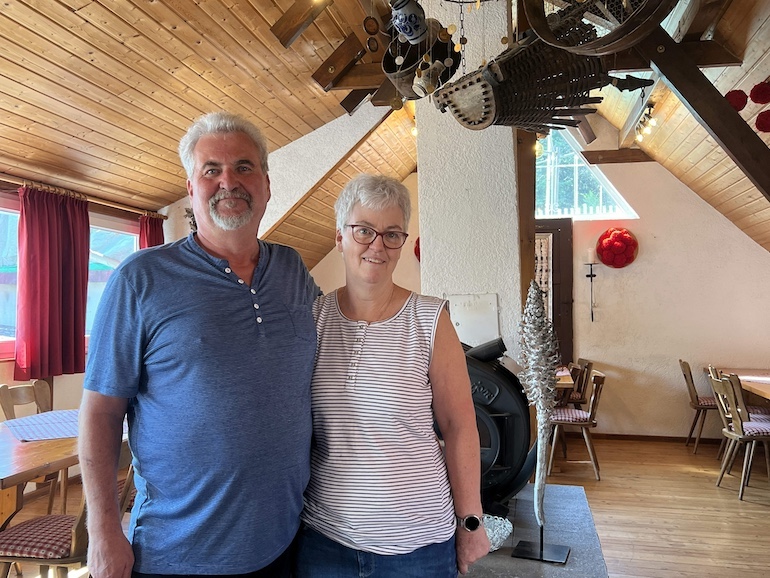
Hubert and Ulrike Müller offer traditional dishes like Flammkuchen and Maultaschen at their Weingut Herztal wine tavern in Oberkirch. Photo by Beth Reiber
But Franz Fies is an infant compared to Oberkirch’s wine industry, which began around 1310 and supplied wines to Strasbourg’s cathedral for mass. Ninth-generation Hubert Müller can trace his family’s wine-making to 1680, though he thinks it probably goes back further before the Thirty Years War (1618-1648) destroyed most records. Together with his wife Ulrike, the Müllers Weingut Herztal winery produces Riesling, Spätburgunder (pinot noir), Grauburgunder (pinot grigio), Weissburgunder (pinot blanc), Sauvignon blanc, Chardonnay, Gewürztraminer, Merlot, and more from their 20 acres planted with 12 different grapes.
“The product he is pouring into the glass is his soul,” Ulrike says during a sampling of their wines, which is why they vow never to mass produce. In addition to a shop, Weingut Herztal offers a rustic and cozy Strausswirtschaft (seasonal wine tavern), with indoor and outdoor seating for Baden’s typical dishes.
Baden’s Favorite Dishes
Although wine takes center stage in Baden, there are plenty of unpretentious dishes to accompany it. In addition to charcuterie platters of artisanal cheeses, cured meats, and hearty bread try Flammkuchen, a flat pizza-like bread topped with bacon, onion, or cheese. Still hungry? Then order Maultaschen, a kind of ravioli filled with meat, onions, and spinach.
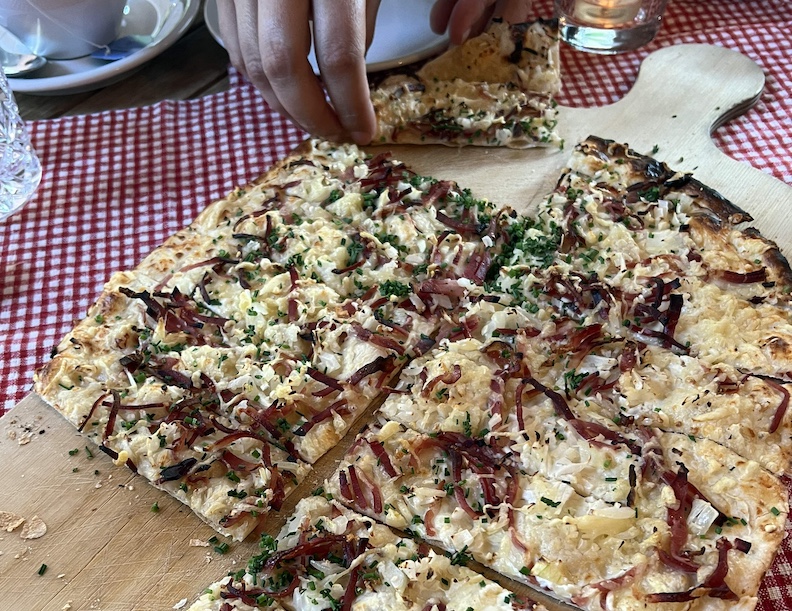
Flammkuchen is the Black Forest’s version of pizza, topped with bacon, cheese and other goodies. Photo by Beth Reiber
More substantial are Zwiebelrostbraten (roast beef with crispy onions), Black Forest trout, smoked Black Forest ham, and Wienerschnitzel (breaded, pan-fried veal cutlet). You can order Spätzle (egg noodles) or kick it up a notch with Kässpätzle (cheesy noodles). Seasonal offerings include venison, fresh mushrooms, chestnuts, and white asparagus. In any case, save room for that Black Forest Cake.
Tours, Trails and Themed Hikes
During the warmer months of the year (generally April or May through October), many towns offer seasonal events. Gengenbach provides a free Night Watchman tour of its old town, which follows in the footsteps of medieval guards who watched over the city and announced the time of day. Oberkirch offers a free welcome reception for guests staying in local hotels, followed by a tour of the town.
Other Oberkirch activities include a four-mile, four-course self-guided culinary wine hike that travels from town through vineyards to the ruins of Schauenburg Castle and back, as well as a wine tasting and cellar tour at Oberkircher Winzer, a wine coop that counts 450 regional grape-growing families as members (in fact, three-fourths of Southwest Germany’s family-owned vineyards belong to coops).
With so many distilleries in Ortenau, it’s only natural that there are also self-guided distillery trails. Sasbachwalden in Ortenau offers two Schnapps Distillery Trails (Schnappsbrunnenwege), which lead hikers through woods past 10 refreshment stops, where bottles of schnapps (and often non-alcoholic drinks) have been placed to cool in mountain streams, paid for on the honor system.
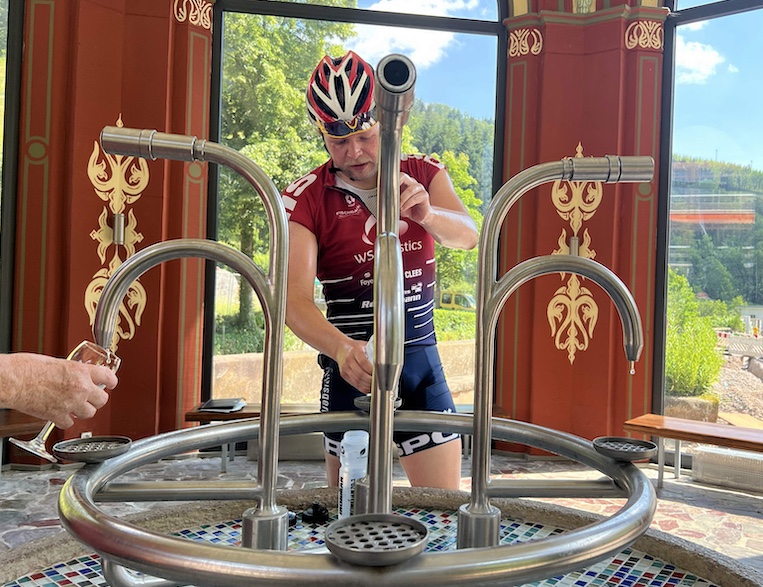
Black Forest mineral water is famous, but perhaps no more so than in Bad Peterstal-Griesbach, where people stop by the landmark Sophienquelle fountain temple to fill up. Photo by Beth Reiber
But lest you think it’s all about alcohol, there are other trails to follow. Jacobsweg, a historic pilgrimage that passes through Germany, Austria, and other countries en route to Santiago de Compostela in Spain, passes through the Black Forest.
Fields of white asparagus, markets offering fresh asparagus, and asparagus festivals greet drivers and cyclists from mid-April to June 24 on the 84-mile Badische Spargelstrasse (Baden Asparagus Route), located along the flat region between the Baden Wine Route and the Rhine.
And for those cuckoo-crazy fans, there’s the German Clock Route (Deutsche Uhrenstrasse), a 186-mile loop through the Black Forest dedicated to the history of timekeeping and linking its most important clockmaking towns.
In other words, Baden and the Black Forest were destinations for slow travel long before the concept became trendy. Puttering encouraged.![]()
Beth Reiber’s most recent stories for EWNS took her to Hinohara, Japan and the ruins of Herculaneum.

